Created by W. E. Johns Nickname(s) Biggles Occupation Pilot Movie Biggles | Full name James Bigglesworth Gender Male Creator W. E. Johns First appearance "The White Fokker" (1932) | |
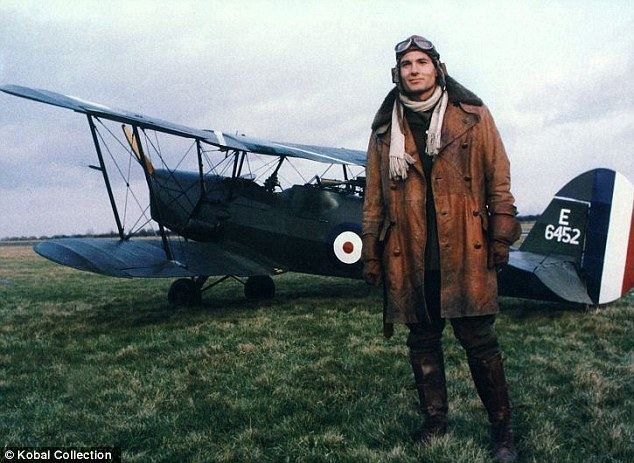 | ||
Portrayed by Neville WhitingNeil Dickson Last appearance The Uncollected Stories (Biggles Air Ace, 1999) Similar Worrals, Oumpah‑pah, Clifton, Cubitus, Suske | ||
James Bigglesworth, nicknamed "Biggles", is a fictional pilot and adventurer, the title character and hero of the Biggles series of adventure books, written for young readers by W. E. Johns (1893–1968). Biggles made his first appearance in the story The White Fokker, published in the first issue of Popular Flying magazine and again as part of the first collection of Biggles stories, The Camels Are Coming (both 1932). Johns continued to write "Biggles books" until his death in 1968, the series eventually spanning nearly a hundred volumes – including novels and short story collections – most of the latter with a common setting and time.
Contents
- Biggles and his creator
- Early life
- First World War
- Between the Wars
- Second World War
- Special Air Police
- Algernon Montgomery Lacey
- Ginger Hebblethwaite
- Flight Sergeant Smyth
- Lord Bertie Lissie
- Tug Carrington
- Erich von Stalhein
- Female characters
- Time
- Racism
- Adult themes
- List of Biggles books
- Television
- Films
- Video games
- Comics
- In other W E Johns books
- In popular culture
- Monty Pythons Flying Circus
- Other parodies
- References
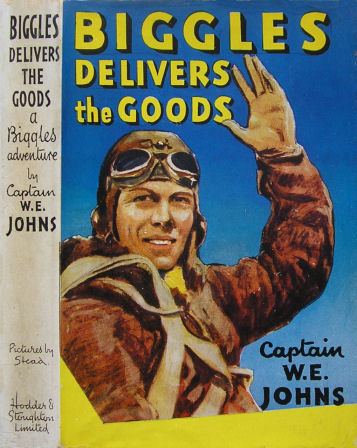
Biggles and his creator
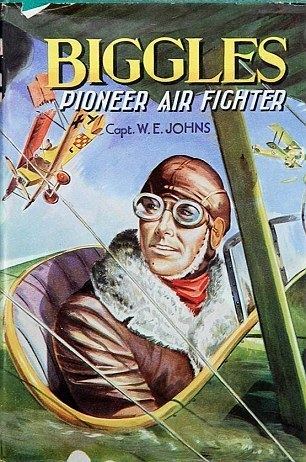
Biggles first appears as a teenaged "scout" (fighter) pilot in the Royal Flying Corps (RFC) during the First World War. He has joined the RFC in 1916 at the age of 17, having conveniently "lost" his birth certificate. Biggles represents a particularly "British" hero, combining professionalism with a gentlemanly air. Under the stress of combat he develops from a slightly hysterical youth prone to practical jokes to a calm, confident, competent leader. He is occasionally given "special" (secret) missions by the shadowy figure of Colonel (initially Major) Raymond (Wing Commander/Air Commodore in later books, reflecting the creation of the Royal Air Force with its own ranks), who is already involved with the intelligence side of operations. Biggles is accompanied by his cousin Algernon ('Algy') Lacey and his mechanic Flight Sergeant Smyth, who are to accompany Biggles on his adventures after the war; added to the team in 1935 is the teenager Ginger Hebblethwaite.

W. E. Johns was himself a First World War pilot, although his own career did not parallel that of Biggles particularly closely. The author's initial war service was as an infantryman, fighting at Gallipoli and on the Macedonian front. He was commissioned as a second lieutenant in September 1917, seconded to the Royal Flying Corps and posted back to England for flight training: Johns served as a flying instructor in England until August 1918, when he transferred to the Western Front. On 16 September 1918 his De Havilland DH4 was shot down on a bombing raid. His observer, Lieutenant Amey, was killed (in two of the stories in Biggles Learns to Fly observers flying with Biggles are killed or badly wounded) but Johns survived to be taken prisoner of war. Johns remained with the RAF until 1927, latterly as an administrative officer rather than a pilot: his final rank was Flying Officer (equivalent to Lieutenant in the RFC) rather than the "Captain" he later claimed as part of his pen name.
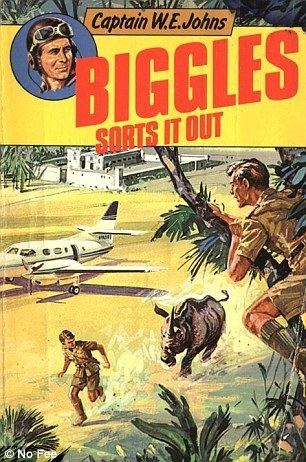
While the purpose of the Biggles stories was to entertain adolescent boys, in the First World War stories, Johns paid attention to historical detail and helped recreate the primitive days of early air combat, when pilots often died in their first combat and before devices such as respirators and parachutes had become practical. Various models on which the Biggles character might have been based have been suggested, including rugby player and WWI flying ace Cyril Lowe, fighter pilot Albert Ball and air commodore Arthur Bigsworth. Johns stated that the character was a composite of many individuals in the RFC (including himself).
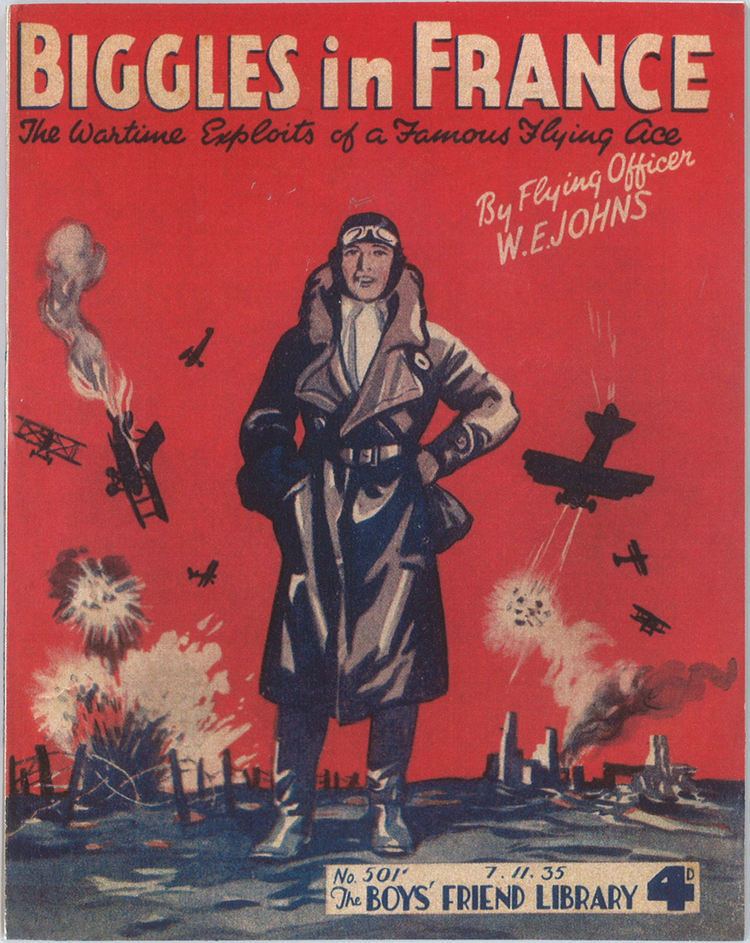
The bulk of the Biggles books are set after the First World War and after Johns' flying career was over. Biggles has an unusually lengthy career, flying a number of aircraft representative of the history of British military aviation, from Sopwith Camels during the First World War, Hawker Hurricanes and Supermarine Spitfires in the Second World War, right up to the Hawker Hunter jet fighter in a postwar adventure Biggles in the Terai. In these later books geographic and historical accuracy is rather less evident and the sometimes rather grim detail of the first stories is moderated, in deference to the increasing popularity of the Biggles books with a younger audience than the older adolescents at which they were initially targeted. The books were popular and were eventually translated into Czech, Danish, Dutch, Finnish, Flemish, German, Hungarian, Icelandic, Italian, Norwegian, Portuguese, Spanish and Swedish.
Early life
According to stories in The Boy Biggles and Biggles Goes to School, James Bigglesworth was born in India in May 1899, the son of an administrator in the Indian Civil Service and his wife (née Lacey). James was the younger of two sons, Charles being the elder by five years. The young James had little contact with European culture and commenced a lifelong affection for India, befriending the local Indian boys, exploring the countryside and learning to speak fluent Hindi. He retained a lifetime gift for languages and as an adult spoke French and German fluently, with a "fair command" of various other languages. He spent holidays in England, under the custody of "Dickpa", an eccentric uncle and inventor who lived in rural Norfolk. When Biggles, now an adult, visits Dickpa, his father's brother, again, an adventure begins that takes both men to Brazil. Biggles then attended Malton Hall School in Hertbury, England. His first encounter with an aircraft was with a Blériot that landed on the school cricket ground.
First World War
Biggles left school and initially joined the army as a subaltern in the Rifle Regiment in 1916. He transferred to the RFC and learned to fly in the summer of 1916, at No. 17 Flying Training School, which was at Settling, Norfolk, flying solo after two hours of instruction. He then attended No. 4 'School of Fighting' in Frensham, Lincolnshire.
Posted to France with under 15 hours, dual and solo, he first flew in combat in September 1916 with 169 Squadron, RFC, (commanded by Major Paynter). His observer was another youth named Mark Way, a New Zealander. Biggles began flying the F.E.2b "pusher" and later the Bristol F2B. In late summer 1917, he was transferred to 266 Squadron RFC, commanded by a Dubliner, Major Mullen. With 266 Squadron, Biggles flew the Sopwith Pup and the famed Sopwith Camel, developing a friendly rivalry with 'Wilks' (Captain Wilkinson) and the S.E.5s of 287 squadron and forming a close friendship with his young cousin Algy (the Hon. Algernon Montgomery Lacey). A study of the short stories featuring his First World War exploits, suggests that he claimed at least 32 kills and was shot down or crash-landed eight times. He was awarded the Distinguished Service Order and the Military Cross and bar.
Between the Wars
After the Great War, Biggles' adventures as a freelance charter pilot, took him around the world in an unidentified amphibian named the "Vandal" (often illustrated on covers, anachronistically, as either a Supermarine Walrus or Supermarine Sea Otter). The nearest "real" aircraft that fits W. E. Johns description of the "Vandal", is a Vickers Viking Mk 4. His team grows when he and Algy meet young Ginger Hebblethwaite in The Black Peril, while foiling a possible German plot against Britain. Post-Second World War editions of the book change this to a Russian plot. Ginger brings the energy and daring of youth to these and many of their later adventures. Between the wars Biggles and his friends mix their own escapades with ventures on behalf of British Secret Service.
Second World War
Biggles returned to service in the Second World War, initially with a Supermarine S6B type machine in the Baltic Sea and then to defy the Nazis and their allies in Norway. He then took up his post as Commanding Officer of 666 Squadron, RAF, a Special Duties squadron that fought in the Battle of Britain before being sent around the world on specific assignments. Biggles, Algy, Smyth and Hebblethwaite are joined by a new companion, the monocle-wearing Lord Bertram 'Bertie' Lissie. The changed venue forced Johns to update his material with references to new flying slang and aeroplanes, unsuccessfully at first but later with more realism. Biggles' new squadron includes a diverse cast, including the American 'Tex' O'Hara (from Texas), the Welshman 'Taffy' Hughes, the Cockney 'Tug' Carrington, the Oxford graduate Henry Harcourt and 'Ferocity' Ferris from the streets of Liverpool.
Special Air Police
After the Second World War Johns reinvents Biggles' career yet again, with his former boss the Air Commodore Raymond hiring him as a "flying detective" for Scotland Yard. Biggles returns to his rooms in Mount Street, Mayfair and assumes a role as head of the new Special Air Police division with Algy, Ginger and Bertie making up the flying squad. The group takes on criminals who have taken to the air, both at home in Britain and around the globe, as well as battling opponents behind the Iron Curtain. The team fly a wide variety of machines, with Auster and Percival types doing much of the work.
Johns continued writing Biggles short stories and novels up until his death in 1968; in all, nearly 100 Biggles books were published.
A final unfinished novel Biggles does some Homework shows Biggles at last preparing to retire and meeting his mixed-race replacement; Johns died while writing this novel. The 12 completed chapters were issued privately in 1997.
Algernon Montgomery Lacey
The Honourable Algernon Montgomery Lacey or “Algy” is a cousin, who is posted to Biggles' flight in 266 Squadron by the influence of his aunt. Despite initial misgivings, the two soon become very close friends and eventually Algy adopts the role of Biggles' second in command. In the books set in the 1930s, Algy, Ginger and Smyth become Biggles' regular companions. Algy starts off in the books as an irresponsible youngster but later on as he ages he becomes more sarcastic and pessimistic.
Ginger Hebblethwaite
Ginger (his real forename is never revealed) first appears in The Black Peril (1935) as a teenage runaway found hiding in a railway shed. Ginger left his father, a mineworker in Smettleworth, after an argument about Ginger's determination to become a pilot. When he first meets Biggles, he tells him he is on his way to London to join the RAF. Biggles immediately calls him Ginger because of his red hair. He proves his worth by rescuing Biggles from some enemy agents. He becomes one of the regular team and is often Biggles's chosen companion. He is a talented mechanic and his speech is peppered with youthful slang and Americanisms, learned from the cinema.
Flight Sergeant Smyth
Biggles' trusty mechanic and logistic organiser since they first worked together in 266 Squadron during the First World War. Smyth, aside from being a mechanic in both world wars in Biggles's squadron, also joins them on some journeys to act as mechanic, like Cruise of the Condor and Goes to War.
Lord Bertie Lissie
First appearing in Spitfire Parade (1941), Lord Bertie is a pilot in 666 Squadron. An eccentric former racing driver, who flies with a hunting horn and a monocle, Bertie joins Biggles in the Air Police in most of the post-war stories. He is a brave and talented fighter, an expert shot and he has a lot of handy knowledge on a range of unusual subjects.
Tug Carrington
A counterpoint to Lord Bertie, Tug is a boxer from the slums of London. His parents being killed in the war, Tug is out for revenge and can be a very risky person to have around. He scorns alcohol, much to the amusement of his fellow squadron members. After the war, in return for Biggles setting him up for a job as a London cabby, he occasionally helps Biggles and his gang on their missions after the Second World War.
Erich von Stalhein
Biggles's greatest opponent is the German intelligence officer Erich von Stalhein, a member of an old Prussian family of soldiers. They first meet in Biggles Flies East, in which Biggles is a spy in the Middle East during the First World War , having some narrow escapes. Stalhein returns as an adversary in numerous other adventures: in Biggles & Co. he is the leader of a group of smugglers based in a medieval castle somewhere in East Germany, under Soviet occupation. As the Cold War begins, Stalhein enters the services of the Communist bloc, until his new masters imprison him on the island of Sakhalin, from where Biggles helps him to escape in Biggles Buries a Hatchet. Stalhein then settles in London and he and Biggles remain in touch. It is from Stalhein that Biggles learns that Janis (see "Female characters" below) survived the Second World War and was imprisoned in Czechoslovakia, from where Biggles rescues her and goes on to support her in England.
Female characters
In the Biggles stories, female characters appear infrequently. Despite brief affairs, Biggles and his chums remain steadfastly single. Biggles suffers a disappointment in the First World War, when he falls in love with German spy Marie Janis in the short story Affaire de Coeur set in 1918. Rather than being considered asexual or a repressed homosexual, Biggles' relationship with Janis suggests he is a romantic hero, "tragically loyal to the only woman he ever really loved".
In Biggles & Co. Stella Carstairs, the daughter of the man Biggles helps, turns up. A pilot herself, she is concerned for Biggles's safety and tells him more than once not to take on her father's request.
In Biggles Flies Again (1934), Algy becomes close to Consuelo, the daughter of the President of Bolivia but is dissuaded from continuing the relationship by Biggles, "...unless you intend marrying her". In Biggles Fails to Return (1943), Ginger falls in love with the sister of the French pilot who has flown Biggles into France on a secret mission and at the end of the story Ginger gets to spend several weeks in her company while awaiting transport back to England. The young Ginger is also smitten by the beautiful Polynesian girl Full Moon, in Biggles in the South Seas (1940).
There is a discussion of the issue of Biggles, sex and alcohol in By Jove, Biggles: The Life of Captain W. E. Johns (1981) by Peter Berresford Ellis and Piers Williams.
In the 1950s, a popular Australian radio version of Biggles was made under licence. Johns did not write the scripts and apparently ended the contract after receiving complaints from young readers that the storyline had made Biggles "go soft" by taking up a blonde female lover.
Another female character appears in the form of Worrals (Flight Officer Joan Worralson), eponymous heroine of a related series of books featuring this resourceful and "plucky" member of the WAAF. A further Johns creation, the commando Captain Lorrington "Gimlet" King, also features in a series of books that intersect with Biggles at times.
Time
The settings of the Biggles books are spread over more than 50 years; this produces a number of credibility difficulties, especially for older readers.
Though Biggles and his friends age in the books, they do so much more slowly (and inconsistently) than is historically credible. For instance Biggles (with some of his First World War "chums") who by now should be well into their forties, are still relatively junior squadron officers flying Spitfires during the Battle of Britain. In the stories set after the end of the Second World War Biggles and Algy, in particular, are, by the rules of arithmetic, passing into their fifties and early sixties, while retaining levels of activity and lifestyle more typical of people at least thirty years younger.
Even within a group of stories set in the same time frame there are some chronological inconsistencies:
It is doubtful whether a careful rearrangement of the various First World War stories could result in a coherent sequence.
The author succeeds reasonably well in chronicling developments in aviation technology but social and cultural changes are much more difficult. The cultural and social world of Biggles (whether in the 1930s or some earlier period) does not persist completely unchanged through the whole series – for instance, in an early book, the evidence points to an English nobleman as the perpetrator but Biggles dismisses this out of hand as the gentry would never commit a crime; in a later novel, one of the gentry is the villain. Nonetheless, the social context of the books, viewed in chronological order, does become increasingly old-fashioned, even anachronistic, especially in those works set after the Second World War.
Racism
Since the Biggles books were first published, attitudes to race and ethnicity have changed. During the 1960s and 1970s a perception of Biggles as unacceptably racially prejudiced, especially considered as children's literature, drove Biggles from many public and school libraries.
Biggles was brought up in India, speaks fluent Hindi and has a number of Indian friends and colleagues. In Biggles Goes to School, on one occasion when told to write lines in Latin, he remarks that he would rather do so in Hindi. On another occasion the adult Biggles asserts to Air Commodore Raymond that "while men are decent to me I try to be decent to them, regardless of race, colour, politics, creed or anything else". While individually developed non-white characters are rather infrequent, when they do occur, they are usually "positive", from the Oxford-educated "Chinaman", Li Chi, in Biggles Flies Again and Biggles Delivers the Goods and the perky Polynesian girl, Full Moon, in Biggles in the South Seas, to Alexander MacKay, a part-Red Indian (sic) nicknamed "Minnie" who joins "the chums" as a valued colleague and is even set to inherit Biggles' job in Biggles Does Some Homework. It has been pointed out that the positive characteristics of these characters tend to be such features as relatively light complexions, Western education and general usefulness to our (white) hero and his friends and allies.
On the other hand, when Johns wishes to present an unpleasant "foreigner" he will quite often drop a gratuitous and offensive hint that the person involved is of mixed race. Non-whites taken en masse also tend to be systematically demonised. With the evil "Chungs" of Biggles Hits the Trail and the sub-human "Aboriginals" of Biggles in Australia, in particular, Johns succumbs to the tendency, typical of his time, to apply unpleasant stereotyping to non-white opponents of his hero. No Rest for Biggles, set in Liberia, where he encounters descendants of Jean-Jacques Dessalines and Henri Cristophe plotting to set up a black empire, is another novel which is overtly racist. In Biggles in Borneo, Dayak headhunters are stereotyped as barely human "savages", even though they are Biggles' allies against the Japanese.
Few people would defend the racism in these books (and others in the "Biggles canon") although they are typical of a genre of fiction for young people that was once common.
Biggles Delivers the Goods (published just three years after Biggles in Borneo) repeats the earlier work's plot so closely that the later novel is clearly a revision. In both books, Biggles establishes a secret airfield behind Japanese lines, which is discovered and attacked by the Japanese before he can achieve his objectives. Algy is captured by the Japanese and threatened with execution by a brutal Japanese commandant and rubber (as an important strategic material) figures largely. All ends well in both novels, as a massive air attack relieves the brave defenders of the airfield and defeats the Japanese. The protagonists are also closely paralleled in both novels, although in Biggles Delivers the Goods Li Chi (originally from a short story in Biggles Flies Again) reappears to take the place of a white character from the earlier version; the headhunters, while still milked for "exotic colour", are much more sympathetically treated.
"Adult" themes
The early Biggles stories and novels, especially those set in First World War, were apparently written mainly for older adolescents. Death is treated rather frequently and sometimes in quite a grim fashion. Other "adult themes" are also touched on: more than once Biggles sets out on a mission in a "red mist", inspired by the death of a comrade. The emotional strain of combat is also realistically described, as Biggles becomes a "highly-strung" fidgeting pale youth, lacking his usual sense of humour. In these stories, in particular, alcohol is mentioned occasionally and cigarettes are much in evidence. The early First World War books were reprinted in the 1950s, when the Biggles books had acquired a younger readership and were bowdlerised. In the short story The Balloonatics, as republished in Biggles of the Special Air Police, the prize for capturing a German observation balloon was altered from a case of Scotch whisky to a case of lemonade. The reprint also removes all references to drinking and swearing. The books contain no explicit sexual content and the traditional values of bravery, honesty and fair play are stressed. Romantic stories, which would have bored his younger readers and embarrassed the older ones, are on the whole avoided, with the odd exception, such as in Biggles Looks Back, where he and Stalhein rescue Marie Janis (with whom Biggles was briefly in love in an earlier story) from her prison in Bohemia.
List of Biggles books
Johns died while still writing Biggles Does Some Homework. Although never completed, it was released as a strictly limited edition of 300 copies in paperback. A further limited print run of 300 hardback copies has been printed in 2007 by Norman Wright publishing.
Television
Biggles appeared in a TV series based on the books with Neville Whiting playing the title role. There were 44 B&W untitled episodes of 30 minutes, which were made by Granada and ran from 1 April till 9 September 1960. Biggles was a Detective Air Inspector attached to Scotland Yard. Helping him was Ginger (John Leyton) and Bertie (David Drummond) and they fought against villains like von Stalhein (Carl Duering).
Films
He was also featured in the 1986 feature film Biggles, directed by John Hough with Neil Dickson in the title role. The film attempted to add appeal to the character by adding a science fiction element but it was a commercial and critical failure. Dickson reprised the character in all but name in the Pet Shop Boys' feature film, It Couldn't Happen Here.
Video games
In 1986, a Biggles video game was released as a tie-in to movie Biggles: Adventures in Time by Mirrorsoft for the platforms Amstrad CPC, Commodore 64 and ZX Spectrum. It included levels based in 1917 and other levels set in modern-day London.
Comics
There have been many different versions of Biggles comics published in different countries in Europe, including Great Britain, Belgium, France and Sweden.
The first annual appeared in 1980. Some albums were released in 1990 featuring the Biggles team. The titles are separate from the books though they cover the same war or after war investigation operations of Biggles.
In India, Euro Books published 14 titles of the Biggles Series along with compilations of the same in 2007.
In other W. E. Johns books
Biggles, or members of his team, have appeared in the following Gimlet books
Air Commodore Raymond also appeared in W E Johns' "Steeley Books".
In popular culture
The books are collectors' items and lesser known titles, especially those never released in paperback, are rare. A copy of Biggles and the Deep Blue Sea, fetched $1,000 on eBay. In 2013, most Biggles books were out of print but a core of popular titles have been reprinted from time to time in various editions. Red Fox (a Random House imprint) reprinted a selection of the "pre-1945" titles, with footnotes added to explain slang and military terms used by Johns; fifteen or sixteen of these seem to have been in print in 2013. Collectors interested in acquiring readable copies of the texts (as opposed to mint copies of first editions) have a fair choice of second-hand copies at reasonable prices.
Biggles – The Authorised Biography by John Pearson, published in 1978, added new and embellished elements to the character's history, including the ageing Biggles' (apparent) suicide in a vintage Spitfire c. 1970. Biggles Recounts the Falklands War, by D. Chauvin, M. Uderzo, B. Asso and J. Rideau appeared in 2007. A number of Biggles characters appear in Kim Newman's alternate history novel The Bloody Red Baron. In the Red Dwarf Series III episode "Marooned", Dave Lister burns Arnold Rimmer's copy of Biggles Learns to Fly to stay warm, while stranded on a hostile moon. Later in the Series X opener "Trojan", Rimmer recounts how his brother Howard once painted his rear with orange glow paint, allowing him to read Biggles Flies West for three nights without needing a torch.
In The Thin Blue Line series I episode "The Queen's Birthday Present", it is revealed that inspector Fowler (Rowan Atkinson) is an avid reader of Biggles. Fowler is shocked, when constable Habib (Mina Anwar) suggests that Biggles and Ginger are lovers, something she argues is also the case for Sherlock Holmes and Dr. Watson. Upset, Fowler argues that sex has no part in these stories, hetero or otherwise; "the point of Biggles and of Sherlock Holmes is to solve crimes and kill Germans. And by heaven, that should be enough for any man". The lyrics of the Jethro Tull song, "Thick As a Brick", has a line that mentions Biggles ("So, where the hell was Biggles when you needed him last Saturday?"). Biggles is mentioned several times in the elaborate album cover, which is a parody of a local British newspaper, most significantly in a story entitled "Do Not See Me Rabbit".
Monty Python's Flying Circus
Biggles was parodied in a series of skits on the 1970s British comedy television show, Monty Python's Flying Circus, including one titled "Biggles Dictates a Letter". In the sketch, Biggles (Graham Chapman) behaves in a naive and overreactive manner about the sexual orientation of his comrades, shooting Algy in the process.
Other Monty Python treatments of Biggles include:
Other parodies
Biggles Flies A Fokker Home is a 2011 play written by former cricketer James Graham-Brown under the pen name, Dougie Blaxland. Blogger Reed dé Buch has written a series of short Biggles spoofs, set in the Iraq War called Biggles Over Baghdad, with titles such as Biggles and the Weapons of Mass Destruction and Biggles and the Undersand Railway.
